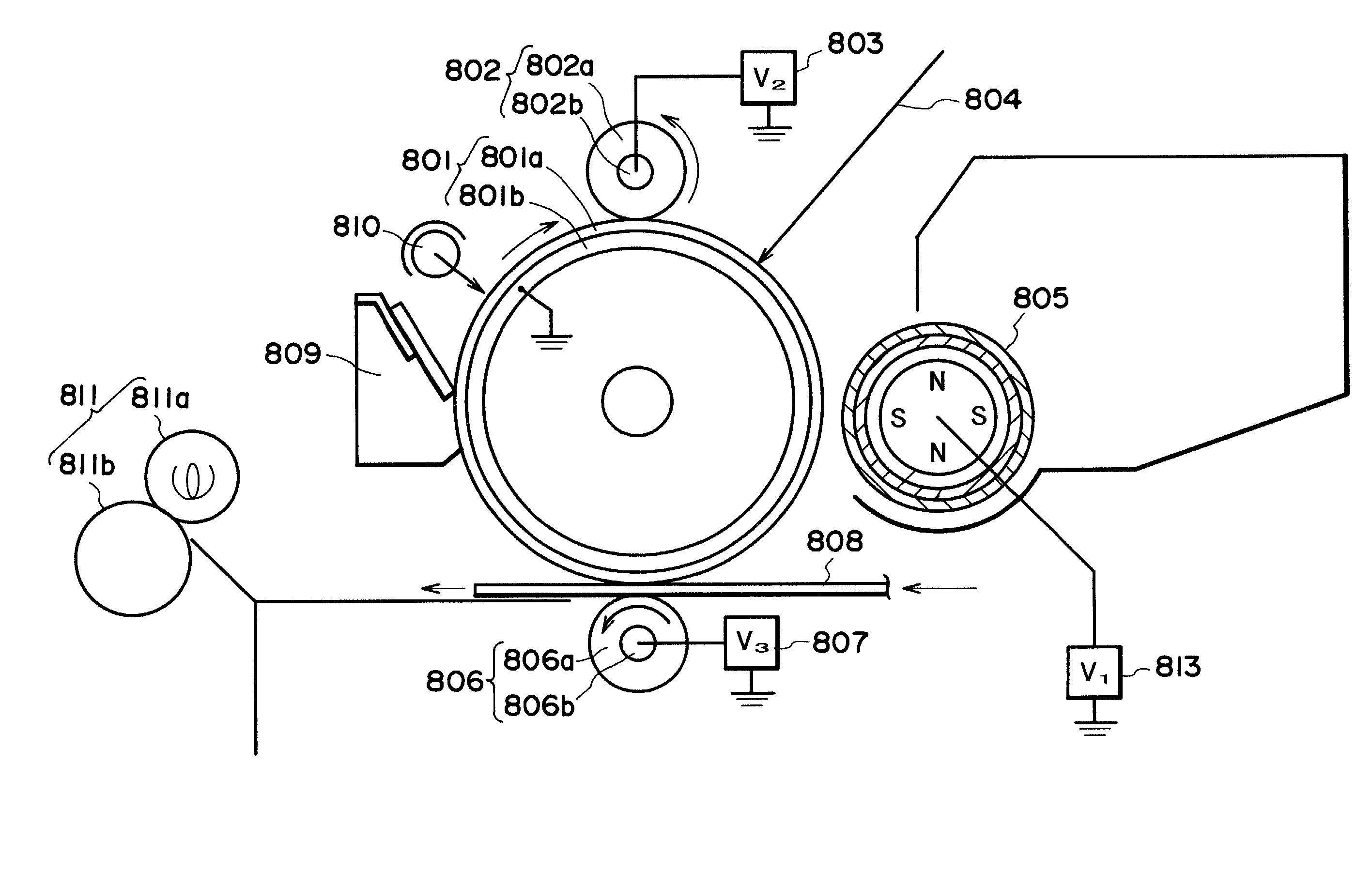Toner, image forming method and process cartridge
a technology of toner and process cartridge, applied in the field of toner, can solve the problems of not necessarily achieving improvement with respect to toners containing sulfur-containing polymers, and the charge control agent alone does not provide all developing performance improvements,
- Summary
- Abstract
- Description
- Claims
- Application Information
AI Technical Summary
Benefits of technology
Problems solved by technology
Method used
Image
Examples
production example 7
[0234] A first-step polymerization was performed in a similar manner as in Production Example 1 by using 200 wt. parts of xylene as the solvent, 35 wt. parts of styrene and 10 wt. parts of butyl acrylate as the monomers and 3 wt. parts of 1,1-bis(t-butylperoxy)-2-methylcyclohexane as the polymerization initiator and holding the system for 8 hours at the reflux temperature. Then, as a second-step polymerization, the reaction vessel was heated to 120.degree. C., and a monomer composition comprising 30 wt. parts of styrene, 18 wt. parts of butyl acrylate, 7 wt. parts of 2-acrylamido-2-methylpropanesulfonic acid and 50 wt. parts of xylene was added dropwise in 1 hour to keep the system at that temperature for 5 hours, thereby completing the polymerization. The xylene was distilled off under a reduced pressure to obtain Sulfur-containing polymer (S-7).
[0235] Sulfur-containing polymer (S-7) exhibited Tg=72.degree. C., Mw=27000, and Av=30.3 mgKOH / g.
production example 8
[0236] Bulk polymerization of monomers comprising 70 wt. parts of styrene, 27 wt. parts of n-butyl acrylate and 3 wt. parts of 2-acrylamido-2-methylpropane-sulfonic acid was effected at 120.degree. C. for 8 hours without using polymerization solvent or polymerization initiator otherwise under similar conditions as in Production Example 1. Then, 50 wt. parts of xylene was added, and the system was cooled to 110.degree. C. Further, a solution of 1 wt. part of t-butyl peroxy-2-ethylhexanoate in 50 wt. parts of xylene was added dropwise in 6 hours, followed by further 1 hour of stirring to recover Sulfur-containing polymer (S-8), otherwise in a similar manner as in Production Example 1.
[0237] Sulfur-containing polymer (S-8) exhibited Tg=58.degree. C., Mw=270000, and Av=8 mgKOH / g.
Production Example 9
[0238] Sulfur-containing polymer (S-9) was prepared in the same manner as in Production Example 1 except that the monomers were changed to 93 wt. parts of 4-t-butylstyrene and 7 wt. parts of ...
production example 1
[0242]
2 Fumaric acid 42 mol. % Trimellitic anhydride 20 mol. % Bisphenol derivative of the 12 mol. % formula (4) (R = ethylene, x + y = 2.4) Bisphenol derivative of the 26 mol. % formula (4) (R = propylene, x + y = 2.2)
[0243] The above ingredients were placed in a reaction vessel equipped with a cooling pipe, a stirrer, a thermometer, a nitrogen-intake pipe and a reduced pressure-generating means, and after adding dibutyltin oxide (as an esterification catalyst), the system was heated to 160.degree. C. in a nitrogen atmosphere. Then, the pressure was reduced to ca. 15 hPa, and the temperature was raised to 200.degree. C., followed by maintenance of the temperature and pressure for 3 hours to complete the esterification to obtain Polyester resin (PL-1) of low-molecular weight-type, which contained substantially no THF-insoluble matter and exhibited an acid value (Av) of 26 mgKOH / g.
PUM
| Property | Measurement | Unit |
|---|---|---|
| Temperature | aaaaa | aaaaa |
| Length | aaaaa | aaaaa |
| Fraction | aaaaa | aaaaa |
Abstract
Description
Claims
Application Information
 Login to View More
Login to View More - R&D
- Intellectual Property
- Life Sciences
- Materials
- Tech Scout
- Unparalleled Data Quality
- Higher Quality Content
- 60% Fewer Hallucinations
Browse by: Latest US Patents, China's latest patents, Technical Efficacy Thesaurus, Application Domain, Technology Topic, Popular Technical Reports.
© 2025 PatSnap. All rights reserved.Legal|Privacy policy|Modern Slavery Act Transparency Statement|Sitemap|About US| Contact US: help@patsnap.com



